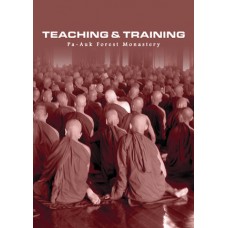TEACHING & TRAINING
Pa-Auk Forest Monastery
by BHIKKHU MONEYYA
ISBN 983-3512-72-0
IJ171/10
Size: 5.5” x 8.25”
Pages: 112 pages
Teaching & Training was written by
one of my disciples here at
Pa-Auk Forest Monastery.
I believe that newcomers will find
this book especially helpful.
~ Pa-Auk
Tawya Sayadaw
(Abbot of Pa-Auk Forest Monastery)
This book
began with a general discussion of the Four Noble Truths, the threefold
training and the seven stages of purification. It then touched on some of the
primary teaching methods employed at Pa-Auk Forest Monastery, as described in Knowing
and Seeing. Topics covered include:
training in morality;
mindfulness of breathing;
four-elements meditation;
the analysis of ultimate materiality and ultimate mentality;
dependent origination;
the practice of vipassanā;
the sixteen insight-knowledges;
and the four stages of enlightenment.
This current edition of Teaching & Training contains a number of important
updates and revisions that were made after the printing of the second and third
editions. These include: more detailed and accurate information on dependent
origination, stream-entry, Right View and wrong view, the sixteen
insight-knowledges, the thirty-one realms and the practice of ānāpānasati; an
update to the biography of the Sayadaw; updated listings in the Resource Guide;
additional footnotes; revised translations; a new daily schedule, and more. It
is the author hope that these many small improvements will help to make
Teaching & Training a more useful and informative handbook.
ABOUT THE AUTHOR
The Venerable Acinna, commonly referred to as the “Venerable Pa-Auk Tawya
Sayadaw” (and, in less formal circumstances, as “Pa-Auk Sayadaw”), is the
current abbot and principal teacher at Pa-Auk Forest Monastery. “Sayadaw” is a
Burmese honorific title meaning “respected teacher.”
The Sayadaw was born in 1934, in Leigh-Chaung Village, Hinthada Township, in
the delta region about one hundred miles northwest of the capital, Yangon. In
1944, at age ten, he ordained as a novice monk (samanera) at a monastery in his
village. During the next decade, he pursued the life of a typical
scholar-novice, studying the Pāli Texts (including Vinaya, Suttas and
Abhidhamma) under various teachers. He passed the three Pāli language
examinations while still a novice.
In 1954, at age twenty, the Sayadaw received the higher ordination as a
bhikkhu. He continued his studies of the Pāli Texts under the guidance of
learned elder monks. In 1956 he passed the prestigious Dhammācariya
examination. This is equivalent to a BA in Buddhist Pāli Studies and confers
the title of “Dhamma Teacher.”
During the next eight years, the Sayadaw continued his investigation into the
Dhamma, travelling throughout Myanmar to learn from various well-known
teachers. In 1964, during his tenth “rains retreat” (vassa), he turned his
attention to intensifying his meditation practice and began to practise “forest
dwelling.” Although he continued with his study of the Pāli Texts, he now
sought out and gained instruction from the revered meditation teachers of those
times.
For the next sixteen years, he made forest dwelling his primary practice. He
spent these years in the southern part of Myanmar, in Mon State: three years in
Mudon Township (just south of Mawlamyine) and thirteen years in Ye Township
(approximately one hundred miles down the coast). During this period, he lived
a very simple life, devoting his time to meditation and study of the Pāli
Texts.
In 1981 the Sayadaw received a message from the abbot of Pa-Auk Forest
Monastery, the Venerable Aggapannā. The abbot was dying and asked the Venerable
Acinna to look after his monastery. Five days later, the Venerable Aggapannā
passed away. As the new abbot of the monastery, the Venerable Acinna became
known as the “Pa-Auk Tawya Sayadaw.” Although he oversaw the running of the monastery,
the Sayadaw would spend most of his time in seclusion, meditating in a bamboo
hut in the upper forested area, which covered a deserted range of hills running
along the base of the Taung Nyo Mountain Range. This area later came to be
known as the Upper Monastery.
Since 1983, both monastics and laity have been coming to study meditation with
the Sayadaw. Foreign meditators began to arrive at the monastery in the early
1990’s. As the Sayadaw’s reputation steadily grew, the Upper Monastery
gradually expanded from a simple bamboo hut and a handful of disciples to more
than two hundred and fifty kutis (meditators’ huts) in the forest; a large
two-storey meditation hall for the men; a library (with office, computer room
and men’s dormitory on the lower levels); a clinic; a hospital; an almsgiving
hall; a two-storey refectory; and a reception hall and dwelling for the
Sayadaw. In the Lower Monastery, facilities include more than one hundred and
eighty kutis, a new kitchen and, for the women, a large three-storey meditation
hall (with sleeping quarters on the ground floor) and a five-storey dormitory
(still under construction).
Currently, there are more than one hundred and thirty foreign monks, nuns and
lay practitioners residing at Pa-Auk Forest Monastery. During our three-month
rains retreat, the total monastic population averages between six and seven
hundred. Together with laypeople, the monastery population sometimes tops
fifteen hundred during festival times. In 1997 the Sayadaw published his magnum
opus, a massive five-volume work titled The Practice that Leads to Nibbāna,
explaining the entire course of teaching in detail and supported by copious
quotations from the Pāli Texts – it is currently available only in Burmese and
Sinhalese. On January 4, 1999, in public recognition of the Sayadaw’s
achievements, the government bestowed upon him the title Agga Mahā
Kammatthānācariya, which means “Highly Respected Meditation Teacher.”
The Sayadaw speaks fluent English and has lectured and led retreats outside of
Myanmar since 1997. In December of 2006, he travelled to Sri Lanka to undertake
a long-term personal retreat, staying in seclusion and suspending his teaching
schedule throughout 2007. As of this printing, his teaching schedule for 2008
includes a four-month retreat in the United States, July – October, to be held
at the Forest Refuge in Barre, Massachusetts, USA.
TEACHING & TRAINING
- Product Code: IJ171/10
- Availability: 873
-
0.00

